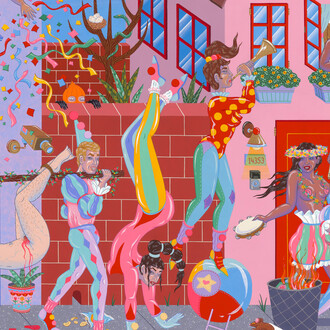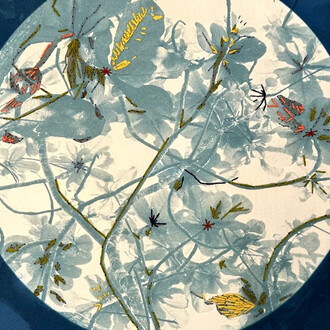GGLA is proud to present Nallthat, a solo exhibition by Los Angeles-based artist Aaron Douglas Estrada, the artist’s first solo exhibition with the gallery. Layering the personal, historical and psychological connections that we have with place and how material carries with it such incredible significance, Estrada honors his hometown of Los Angeles through an expansive approach to making.
Upon entering the exhibition space, we’re first struck with a pepto-bismol pink wall upon which three of Estrada’s intricate wall sculptures hang, thin ropes of razor wire protruding from the circular compositions and weaving together to form individual spider web forms. At the center of these three works are intricate collages that are framed by and protrude off the wall, each with its own thick spool of razor wire. The wire–a potent symbol for protection, mobility and the ways in which we create and police borders, becomes a foundational material throughout the show making repeat appearances from work to work and space to space. The collages housed within these sharp spools incorporate such disparate materials as used t-shirts, wood, assorted labels from veladoras (candles), and touches of blood and smoke–residue of an arduous making process, with these components all neatly finished with a polished lug nut that sits at the center.
The single use plastic bag serves as another recurring and vital marker throughout the exhibition, with the bags speaking to a range of issues, from the obvious environmental ramifications, to notions surrounding class, disposability and the fragility of life cycles. Using an idiosyncratic craft technique, Estrada melts the bags together with other materials, incorporating these thin and transparent shells into larger amalgams that have the feel of a textile or handmade paper. The resulting patchworks often incorporate imagery and melted plastic from catholic candles that feature various saints and prayers, to the occasional dried marijuana leaf, with this melding of materials speaking to the sacred, profane and mundane simultaneously. The backroom of the gallery features an entire wall lined with an immersive plastic bag collage, as a multifaceted chandelier composed of chain and razor wire sits in the foreground, charms and mementos hanging from the hard metal, the sharp arcs of metal moving with a decisive delicacy over their layered backdrop.
As our eyes shift from the hanging chandeliers and wall-based pieces to the gallery’s floor, we’re met with white and black shoe prints that are left from a carefully selected grouping of Nike Cortez, Reebok Classics and Converse Allstars. The significance of these shoes is not lost on the artist, with the Cortez alluding to both the atrocities committed by Spanish colonizer Hernán Cortés, and a staple shoe within gang culture in Black and Brown communities. The Reebok’s design incorporates the British flag, another potent symbol of colonialism and domination, and the Converse All Stars stand as a reference to the Catholic missions and their forced religious conversion of indigenous people. With each meandering footstep, were led to a different altar or repository, with Estrada’s ability to examine and blend gives his works the feel of reliquaries–sacred containers for the hopes and dreams, loss and pain and the prayers and collective achievements of Los Angeles communities.
















